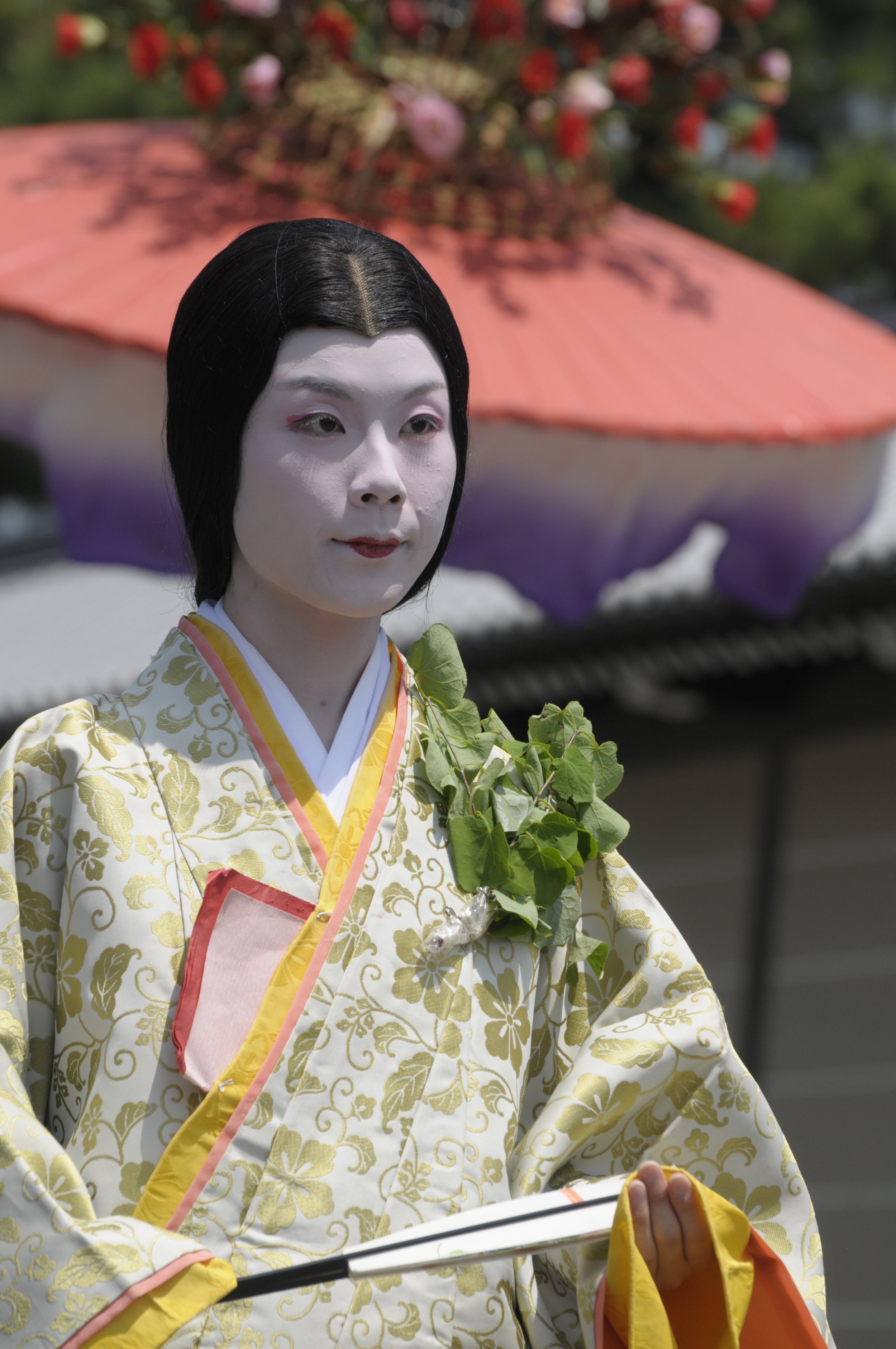Aoi Matsuri Festival
The picturesque Heian Period Procession
(This article was first published in the KVG May, 1988 by Nick Hagel)
May in Kyoto means Aoi Matsuri, a festival that consists mainly of a procession on May 15th of 600 people dressed in imperial court costumes of the Heian period (794-1185). Since its origins reach way back to the 6th century, even before Kyoto was founded as Japan’s capital, the Aoi Matsuri is often called the oldest festivals in the world. Whether this is true or not, the festival’s history is certainly very long.
Splendid Hana-gasa flower umbrella: Photo by Jeremy Hoare
It all started during the reign of Emperor Kinmei (540-571), when the region was lashed by severe storms resulting in bad harvests. A diviner determined that the deities of Kamigamo and Shimogamo Shrines, the two shrines on the banks of the Kamo River, were angry at the impiety of the people. The emperor immediately dispatched an emissary to take gifts to the shrines and pay homage to their deities. Everything returned to normal, and to make sure it stayed that way, the emperor ordered official of the imperial court to make regular visits to the two Kamo Shrines.
Following Kyoto’s founding in 794, the first emperor to reign here, Kanmu, personally visited the Kamo Shrines, recognized their deities as protectors of Kyoto, and in 807 officially established the Aoi Matsuri as an annual event. It soon became so famous that it was simply called the Festival.
The Aoi Matsuri became most spectacular during the mid-Heian period. It is this era, thought by many to be the finest in Kyoto’s history, that today’s festival attempts to recreate. The destructive Onin Civil War (1467-1477) brought the festival to an end for more than 200 years. It was revived in 1694, only to be interrupted again between 1867 and 1883 by the Meiji Restoration, and between 1942 and 1952. Since then the festival has flourished again.
It is now one of the main events in Japan’s annual festival calendar, and attracts crowds of spectators.
One feature of the festival, which has in fact given it its name, is the wearing by all participants of sprigs of Aoi (wild ginger) whose leaves are heart-shaped.
The festival procession consists of two parts: the imperial messenger’s retinue and the Saio-dai. First comes the Chokushi, the messenger himself, who rides a brightly decorated horse. He is acoompanie by an escort of servants on foot, a group of court nobles and ladies, a black lacquered ox-drawn cart decorated with wisteria, several large flower-decorated umbrellas, each carried by four men, and a party of mounted warriors dressed in maroon robes and carrying bows and arrows.
The Saio-dai was, during the Heian period, a daughter of the emperor who served as the head priestess of both Kamo Shrines. The Saio system lasted from 810 until about 1200, but these days it is briefly revived for Aoi Matsuri, a different woman being chosen each year from among Kyoto families.
She is in many ways the focus of the parade, but has the unenviable task of having to wear simultaneously no less than twelve kimonos. She is easily recognizable as the slightly ungainly woman in the hand-carried palanquin.
Although the procession is a great splash of color put on for all to see, the ceremonies held within each shrine are open only to invitation holders. At both, the Chokushi’s petition is presented and gifts given, including a horse which is paraded around the inner shrine to the accompaniment of koto (Japanese harp) music played by the warriors.
After each ceremony at least ten horses with riders are galloped down a special course outside the main shrine compound, to demonstrate the power of the horses being donated, a through-back to the first Aoi Matsuri.
During the first two weeks of May several preliminary events take place. On May 3rd, there is horseback archery (yabusame) at Shimogamo Shrine, intended as part of the ceremony to “purify” the procession’s route, and on May 5th there is horse racing (kurabeuma) at Kamigamo Shrine between two teams dressed in Heian period costumes. These riders are among the leaders of the procession on the 15th.
Photo: Saio-dai on the palanquin; photo by Jeremy Hoare
On the big day the entourage leaves the palace at 10:30 a.m., arrives at Shimogamo Shrine at 11:40 where it stays until 2 p.m., and finally arrives at Kamigamo Shrine at 3:30 p.m. the route gets quite crowded with spectators, especially at the palace and the shrines, so pick a good vantage spot early. For those with stamina, following the slow-moving procession along its whole route can be fun. The best photographs can be obtained by going to the palace park well ahead of 10:30. Before the start one can freely walk among the participants and nap away endlessly. What is more, the green trees and palace walls make for the perfect backdrop – no nasty concrete or traffic light to spoil the authenticity!





